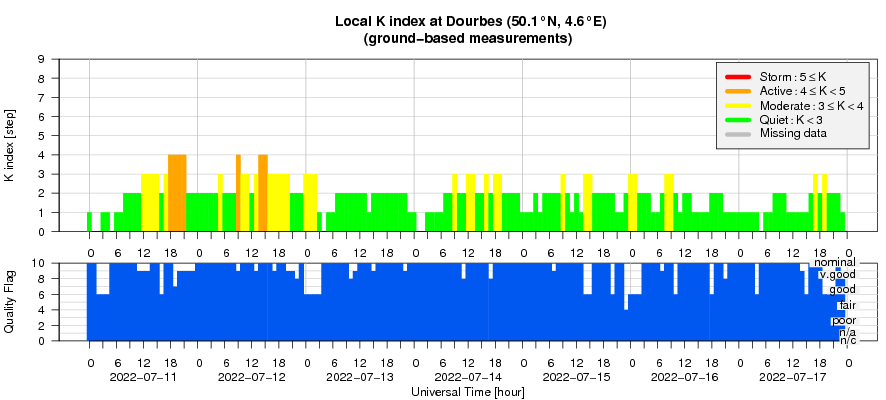- Table of Content
- 1.Snap!...
- 2.COSPAR
- 3.Review of sola...
- 4.Review of geom...
- 5.PROBA2 Observa...
- 6.The Internatio...
- 7.Noticeable Sol...
- 8.Geomagnetic Ob...
- 9.The SIDC space...
- 10.Action!
2. COSPAR
3. Review of solar activity
4. Review of geomagnetic activity
5. PROBA2 Observations (11 Jul 2022 - 17 Jul 2022)
6. The International Sunspot Number by SILSO
7. Noticeable Solar Events (11 Jul 2022 - 17 Jul 2022)
8. Geomagnetic Observations at Dourbes
9. The SIDC space weather briefing
10. Action!
Snap!...
Solar filaments are clouds of charged particles ("plasma") above the solar surface squeezed between magnetic regions of opposite polarity. Being cooler and denser than the plasma underneath and their surroundings, they appear as dark lines when seen on the solar disk and as bright blobs when seen near the solar limb (then they are called "prominences"). These features are not visible in white light, and require special filters such as in the Hydrogen-alpha (H-alpha) line in the red part of the solar spectrum at 656.3nm.
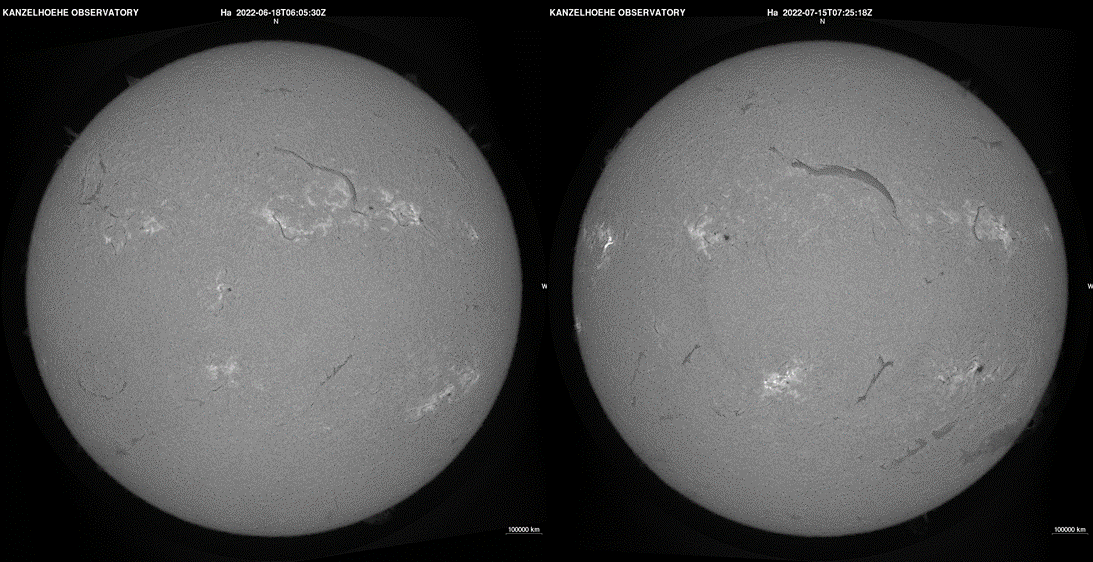
Starting around noon on 15 July, a filament in the Sun's northern hemisphere just west of the central meridian erupted. This concerned the same filament that developed a solar rotation ago, as discussed in this STCE newsitem (https://www.stce.be/news/597/welcome.html ). A comparison between 18 June and 15 July can be found above (Kanzelhöhe Observatory - http://cesar.kso.ac.at/ ). Its length hadn't changed much over these weeks and was, just hours before the eruption, still comparable to the Earth-Moon distance (i.e. a length between 370.000 and 390.000 km). The GONG (https://gong.nso.edu/ ) H-alpha imagery underneath show the eruption with about 3 hours interval. An animation of this eruption is also available in the online version of this manuscript (https://www.stce.be/news/600/welcome.html ). The "wiggling" of the Sun in the animation has nothing to do with the eruption, but is due to image processing as the images are provided by different GONG network stations. The eruption was observed too with the H-alpha telescope of the ROB/USET (https://www.sidc.be/uset/ ) (see the online animation). These H-alpha images show that the filament snapped near its middle, with portions flowing to the east and west along the neutral line ("border" between opposite magnetic fields). Also, a small portion of the east end of the filament survived the initial eruption, preferring to erupt by itself just a few hours later, on 16 July around 03:00UTC.
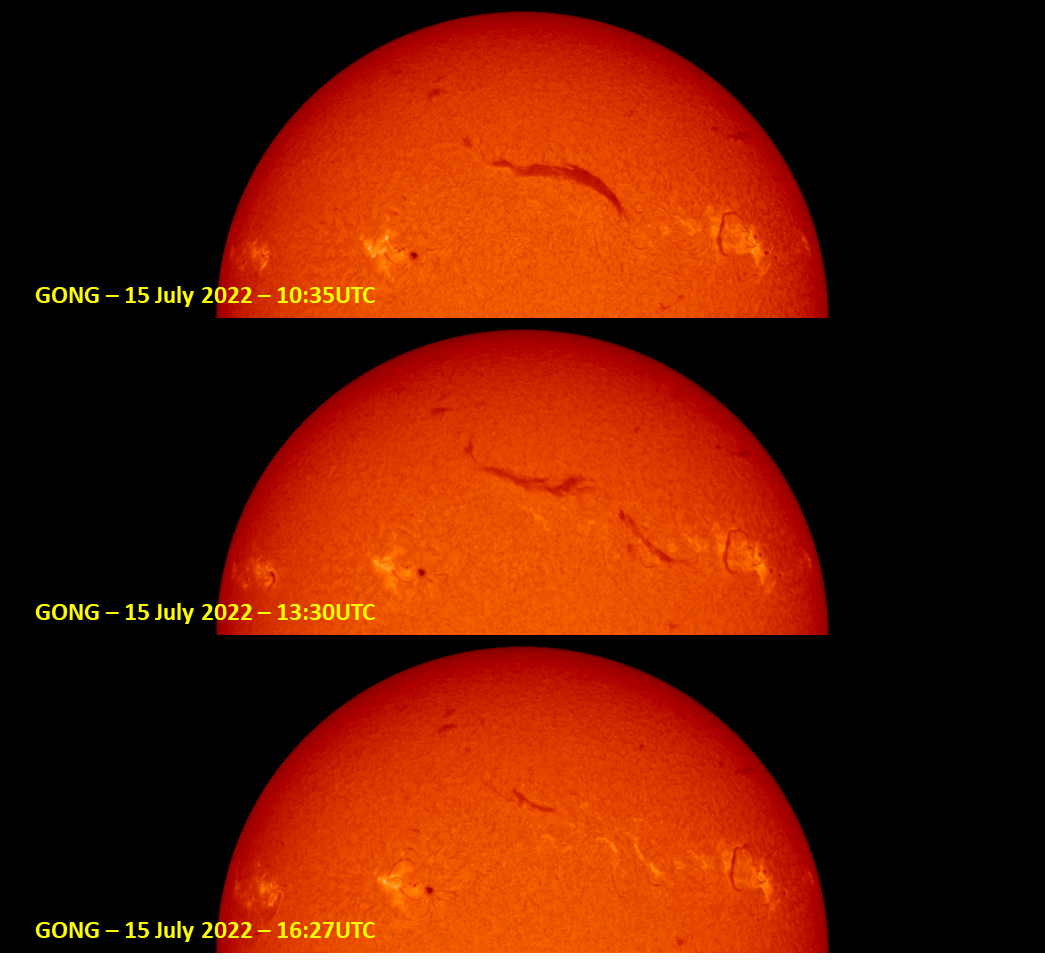
The eruption was also visible in extreme ultraviolet. STEREO-A (https://stereo-ssc.nascom.nasa.gov/ ) is still trailing the Earth by about 25 degrees, and thus observed the eruption a little bit more from the side. Images taken by its EUVI 304 filter, showing the solar atmosphere at temperatures near 80.000 degrees, clearly reveal material being ejected into space (see the annotated images underneath, and the online animation).

Interestingly, PROBA2/SWAP difference images (one image subtracted from the next; https://proba2.sidc.be/swap/movies/20220715_swap_diff.mp4 ) suggest that at least part of the material flowing to the west might have been captured by the magnetic fields of the spotless trailing portion of active region NOAA 3053, as if it was attracted by a magnetic whirlpool.
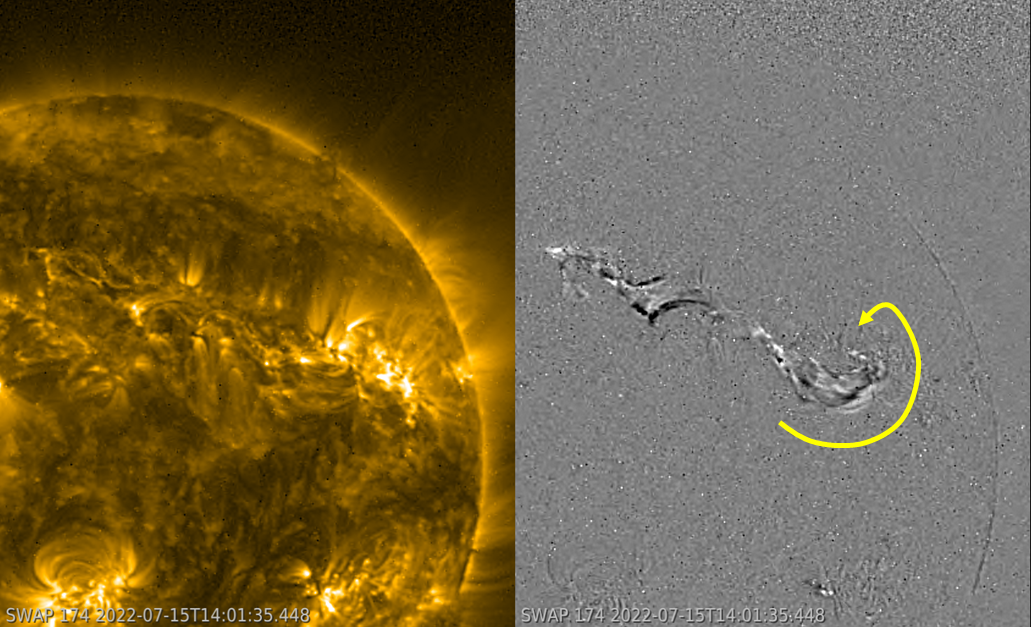
So it was no surprise that a coronal mass ejection (CME) was observed (image underneath). As is evident from coronagraphic difference images by SOHO/LASCO (CACTus - https://www.sidc.be/cactus/ ) and STEREO-A/COR2, the bulk of this partial halo CME was mostly directed to the north and west, but an earth-directed component could not be excluded. Thus, as its plane-of-the-sky speed was determined by SIDC space weather forecasters (https://www.sidc.be/index.php ) to be only around 300 km/s, expectations are that this slow-moving CME will arrive at Earth only late on 19 July or on 20 July.
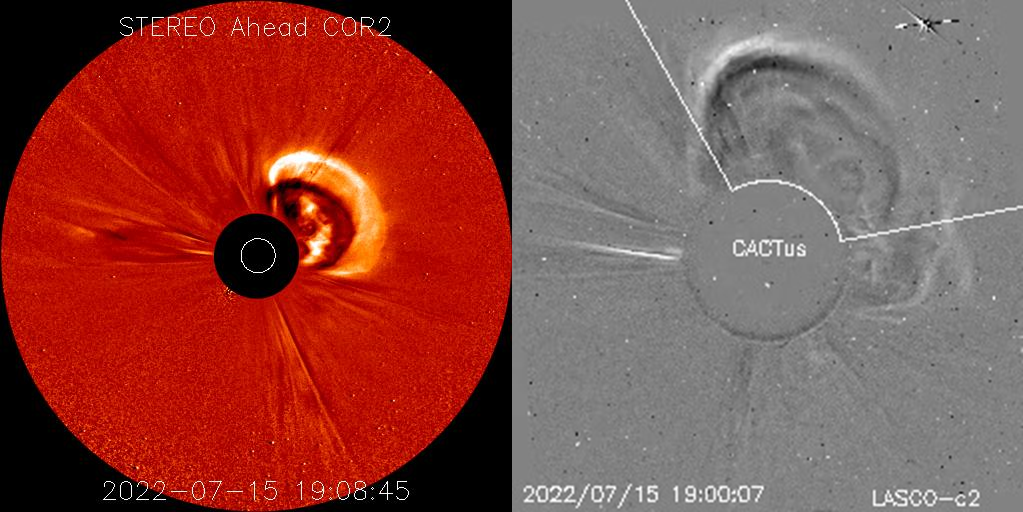
COSPAR
The Scientific Assembly of the Committee on SPAce Research (COSPAR) is at its full swing.
COSPAR brings together experts at the cutting edge of space research: planets, astrophysics, space exploration, earth observations and more.
Hot topics on the agenda for the 2022 assembly include climate change, space weather forecasting, the responsible use of space and challenges and opportunities related to the growing number of private actors in the space domain.
The STCE is in particular involved in space weather forecasting. Christine Verbeke represented the expertise of understanding of coronal mass ejection at the July 20 press conference.
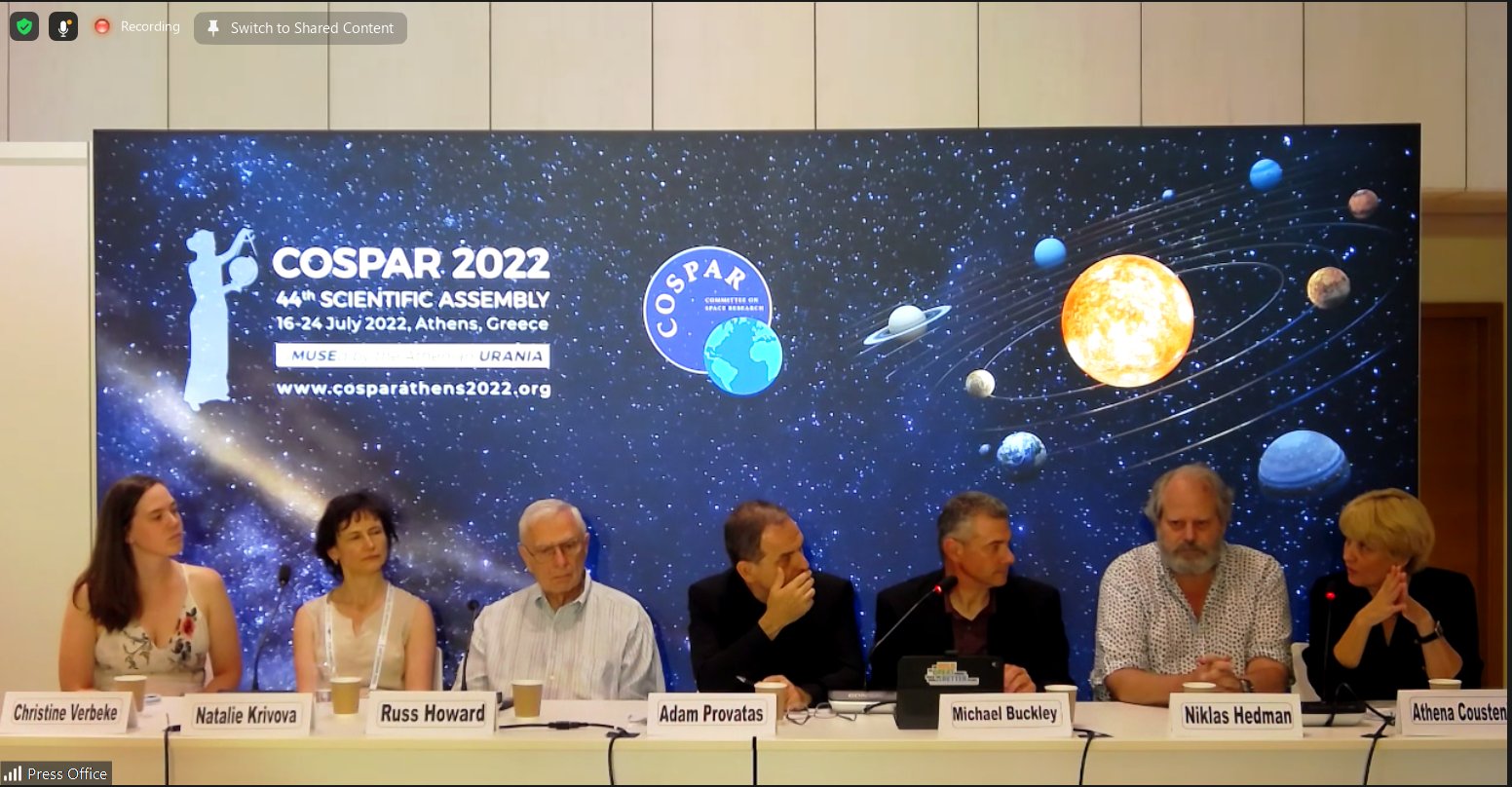
Check it out: https://www.cosparathens2022.org
Review of solar activity
Flaring activity
Solar flaring activity ranged between low and moderate levels. There were 11 numbered active regions on the disk over the course of the week, which produced numerous C-class flares and 6 low level M-Class flares. NOAA AR3056 was most active at the start of the week, while it was near the east limb, producing an M1.3 and an M1.1 flare on July 10 and 11, respectively. On July 14, NOAA AR 3058 also produced two M-flares, including the largest of the week an M2.8 flare peaking at 21:48 UT, while also near the east limb. The remaining two M-flares were both M1 impulsive flares, which were produced by NOAA AR 3057 and NOAA AR 3055 on July 16.
Filament eruptions and Coronal Mass Ejections
There were multiple filaments observed on disk over the week. A filament eruption was observed on July 15 near the central meridian. An associated slow partial halo Coronal Mass Ejections (CME) seen in LASCO-C2 on May 15 from 15:36 UT to the north-west was considered to possibly have an Earth directed component and was predicted to impact Earth late on July 19. No other Earth-directed CMEs were detected in the available coronagraph imagery.
Particles
The greater than 10 MeV proton flux was at nominal levels. The greater than 2MeV electron flux was a nominal levels for the first half of the week and began to increase and crossed the 1000 pfu threshold on July 16. The 24h electron fluence was at normal levels, increasing to moderate levels from July 16.
Review of geomagnetic activity
At the start of the week the solar wind speed was around 400 km/s. This increased gradually on July 12, up to values over 580 km/s, due to the arrival of a high speed stream. The total magnetic field magnitude had a maximum value of 17 nT on July 12 and then decreased to values near 6 nT from July 13. Bz had a minimum value of -14 nT on July 12. The interplanetary magnetic field phi angle was predominantly in the positive sector (directed away from the Sun).
Geomagnetic conditions reached active to minor storm levels on July 12 in response to the arrival of the high speed stream. For the remainder of the week the conditions returned to quiet to unsettled levels.
PROBA2 Observations (11 Jul 2022 - 17 Jul 2022)
Solar Activity
Solar flare activity fluctuated from low to moderate during the week.
In order to view the activity of this week in more detail, we suggest to go to the following website from which all the daily (normal and difference) movies can be accessed: https://proba2.oma.be/ssa
This page also lists the recorded flaring events.
A weekly overview movie can be found here (SWAP week 642).
https://proba2.oma.be/swap/data/mpg/movies/weekly_movies/weekly_movie_2022_07_11.mp4
Details about some of this week's events can be found further below.
If any of the linked movies are unavailable they can be found in the P2SC movie repository here https://proba2.oma.be/swap/data/mpg/movies/
Thursday Jul 14
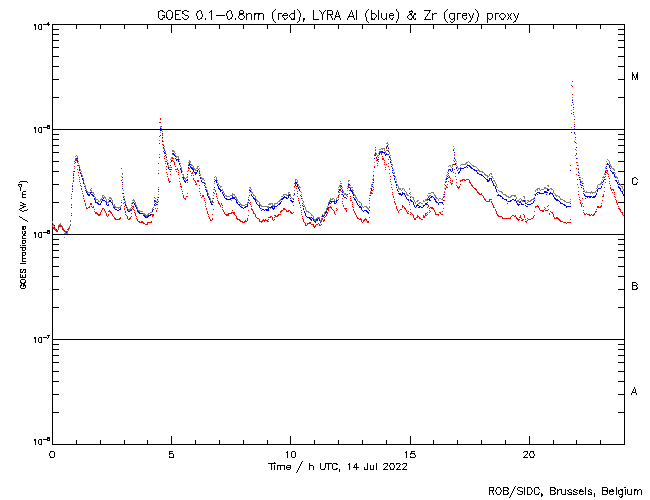
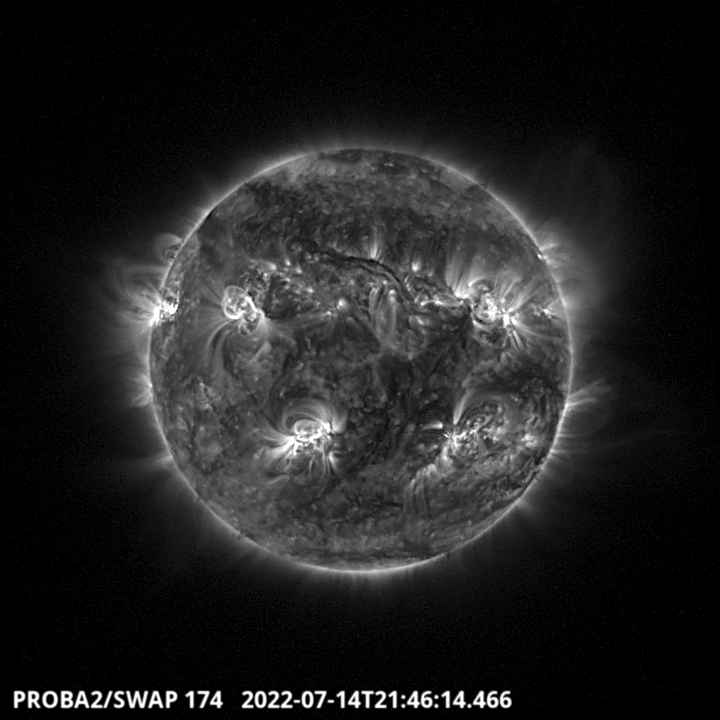
The largest flare of this week has been classified as a M2.8 flare. It was associated with an active region (NOAA AR 3058) located on the north east of the solar disk around 21:46 UT. Find a movie of the events here (SWAP movie) https://proba2.oma.be/swap/data/mpg/movies/20220714_swap_movie.mp4
Friday July 15
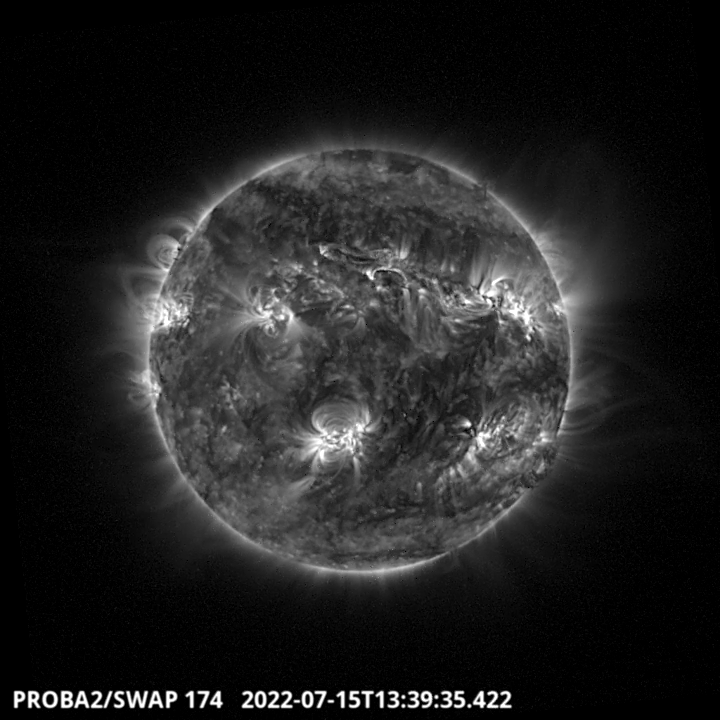
A filament eruption occurred around 13:39 UT on the North West part of the solar disk. Find a movie of the events here (SWAP movie) https://proba2.oma.be/swap/data/mpg/movies/20220715_swap_movie.mp4
Saturday Jul 16
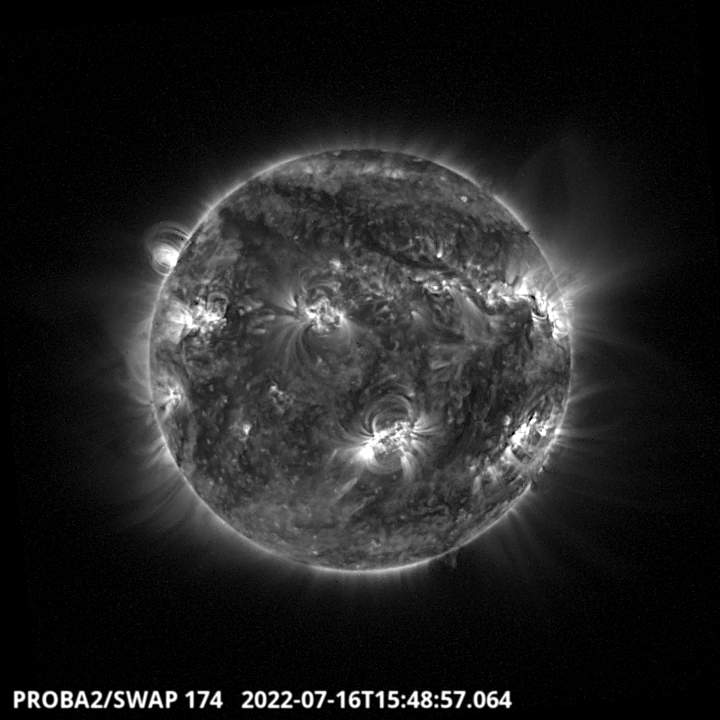
A filament eruption occurred around 15:49 UT on the North West part of the solar disk. Find a movie of the events here (SWAP movie) https://proba2.oma.be/swap/data/mpg/movies/20220716_swap_movie.mp4
The International Sunspot Number by SILSO
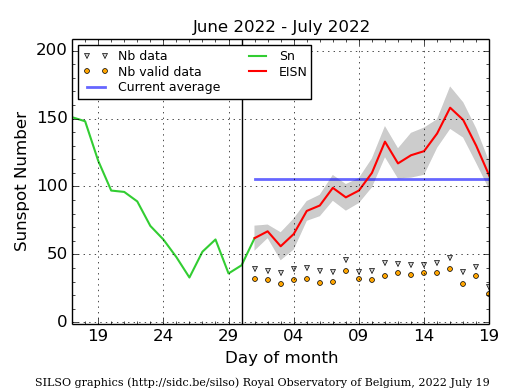
The daily Estimated International Sunspot Number (EISN, red curve with shaded error) derived by a simplified method from real-time data from the worldwide SILSO network. It extends the official Sunspot Number from the full processing of the preceding month (green line), a few days more than one solar rotation. The horizontal blue line shows the current monthly average. The yellow dots give the number of stations that provided valid data. Valid data are used to calculate the EISN. The triangle gives the number of stations providing data. When a triangle and a yellow dot coincide, it means that all the data is used to calculate the EISN of that day.
Noticeable Solar Events (11 Jul 2022 - 17 Jul 2022)
| DAY | BEGIN | MAX | END | LOC | XRAY | OP | 10CM | TYPE | Cat | NOAA |
| 11 | 0908 | 0919 | 0939 | S18E62 | M1.1 | 1F | CTM/1 | 81 | 3056 | |
| 14 | 0422 | 0431 | 0440 | N14E86 | M1.2 | SF | 3058 | |||
| 14 | 2142 | 2148 | 2153 | M2.8 | III/1 | 3058 | ||||
| 16 | 0616 | 0629 | 0634 | N18E20 | M1.1 | 1N | 82 | 3057 | ||
| 16 | 1533 | 1539 | 1544 | S17W53 | M1.4 | 1B | 78 | 3055 |
| LOC: approximate heliographic location | TYPE: radio burst type |
| XRAY: X-ray flare class | Cat: Catania sunspot group number |
| OP: optical flare class | NOAA: NOAA active region number |
| 10CM: peak 10 cm radio flux |
The SIDC space weather briefing
The Space Weather Briefing presented by the forecaster on duty from July 10 to 17. It reflects in images and graphs what is written in the Solar and Geomagnetic Activity report: https://www.stce.be/briefings/20220718_SWbriefing.pdf
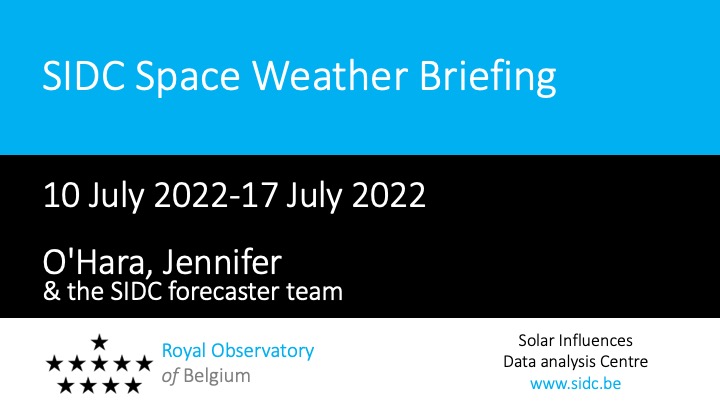
If you need to access the movies, contact us: stce_coordination at stce.be
Action!
Check out our activity calendar: activities and encounters with the Sun-Space-Earth system and Space Weather as the main theme. We provide occasions to get submerged in our world through educational, informative and instructive activities.
If you want your event in our calendar, contact us: stce_coordination at stce.be
* August 25, Public Lecture on Space Weather and Aviation, Astropolis, Oostende, Belgium
* September 24-25 Space Pole Open Days, Brussels, Belgium
* October 24-28, 18th European Space Weather Week, Zagreb, Croatia
* November 21-23, Space Weather Introductory Course - onsite, by the STCE, Brussels, Belgium
* December 5, 6, 8, 9, Space Weather Introductory Course - online, by the STCE, zoom
Check: https://www.stce.be/calendar

